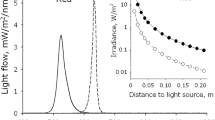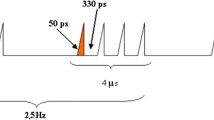Summary
Primary and passaged cultures of fibroblasts (RBMFs) raised from the bone marrow stroma of young rabbits were treated with pulsed electromagnetic fields (PEMFs) from the start of each culture until 1 week after they became confluent. The PEMF treatment had no effect on cell proliferation, estimated by phase contrast microscopy, by3H-thymidine incorporation into DNA, or by total DNA assay. Collagen production, estimated by conversion of3H-proline to3H-hydroxy-proline in nondialyzable material was markedly elevated in postconfluent cultures, but not in cultures that had only just reached confluence. About 65% of3H-hydroxyproline was in low molecular weight form, and a correlation between collagen break-down and cyclic AMP (cAMP) levels in RBMFs was demonstrated by adding dibutyryl cAMP or prostaglandin E2 (PGE2) to the culture medium concurrently with3H-proline. The PEMF apparatus caused an insufficient temperature rise (less than 0.1°C) to account for these results. We propose that the rise in collagen production is consistent with the hypothesis that PEMFs act by reducing cAMP levels in RBMFs, and that thermal effects are insignificant.
Similar content being viewed by others
References
Bassett CAL, Mitchell SN, Gaston SR (1982) Pulsing electromagnetic field treatment in ununited fractures and failed arthrodeses. J Am Med Assoc 247: 623–628
Sharrard WJW, Sutcliffe ML, Robson MJ, Maceachern AG (1982) The treatment of fibrous non-union of fractures by pulsing electromagnetic stimulation. J Bone Joint Surg 64B: 189–193
Mulier JC, Spaas F (1980) Out patient treatment of surgically resistant non-unions by induced pulsing current—clinical results. Arch Orthop Taumat Surg 97: 293–297
Norton LA, Rodan GA, Bourret LA (1977) Epiphyseal cartilage cAMP changes produced by electrical and mechanical perturbations. Clin Orthop 124: 59–68
Korenstein R, Somjen D, Fischler H, Binderman I (1984) Capacitative pulsed electric stimulation of bone cells induction of cyclic AMP and DNA synthesis. Biochim Biophys Acta 803: 60–64
Luben RA, Cain CD, Chen MC-Y, Rosen DM, Adey WR (1982) Effects of electromagnetic stimuli on bone and bone cells in vitro: inhibition of responses to parathyroid hormones by low-energy low-frequency fields. Proc Natl Acad Sci 79: 4180–4184
Fitton Jackson S, Bassett CAL (1980) The response of skeletal tissues to pulsed magnetic fields. In: Richards RJ, Rajan KT (eds) Tissue culture in medical research II. Pergamon Press, Oxford, pp 21–28
Norton LA (1982) Effects of a pulsed electromagnetic field on a mixed chondroblastic tissue culture. Clin Orthop 167: 280–290
Murray JC, Farndale RW (1985) Modulation of collagen production in cultured fibroblasts by a low frequency pulsed magnetic field. Biochim Biophys Acta 838: 98–105
Owen M (1978) Histogenesis of bone cells. Calcif Tiss Int 25: 205–207
Friedenstein AJ (1973) Determined and inducible osteogenic precursor cells. Ciba Foundation Symp 11: 169–181
Prockop DJ, Berg RA, Kivirikko K, Uitto J (1976) Intracellular steps in the biosynthesis of collagen. In: Ramachandran G, Reddi AH (eds) Biochemistry of collagen. Plenum New York, pp 162–273
Gerber H, Cordey J, Perren SM (1978) Influence of magnetic fields on growth and regeneration in organ culture. In: Burny F, Herbst E, Hinsenkamp M (eds) Electrical stimulation of bone growth and repair. Springer Verlag, New York 35–40
Lunt MJ, Barker AT (1984) Pulsed magnetic field therapy for tibial non-union and for rotator cuff tendinitis. Lancet 8389: 1295
Ashton BA, Allen TD, Howlett CR, Eaglesom CC, Hattori A, Owen M (1980) Formation of bone and cartilage by marrow stromal cells in diffusion chambers in vivo. Clin Orthop 151: 294–307
Berg RA, Schwartz ML, Crystal RG (1980) Regulation of the production of secretory proteins: the intracellular degradation of newly-synthesised “defective” collagen. Proc Natl Acad Sci 77: 4746–4750
Lukens LN, (1965) Evidence for the nature of the precursor that is hydroxylated during the biosynthesis of collagen hydroxyproline. J Biol Chem 240: 1661–1669
Sykes B, Puddle B, Francis MJO, Smith R (1976) The estimation of two collagens from human dermis by interrupted gel electrophoresis. Biochem Biophys Res Commun 72: 1472–1480
Ash P, Francis MJO (1975) Response of isolated rabbit articular and epiphyseal chondrocytes to rat liver somatomedins. J Endocrin 66: 71–78
Royce PM, Lowther DA (1979) Fluorometric determination of DNA in papain digests of cartilage using ethidium bromide. Connect Tiss Res 6: 215–221
Brown BL, Albano JDM, Ekins RP, Sgherzi AM, Tampion W (1971) A simple and sensitive saturation assay method for the measurement of adenosine 3′5′ cyclic monophosphate. Biochem J 121: 561–562
Cawston TE, Barrett AJ (1979) A rapid and reproducible assay for collagenase using 14C-acetylated collagen. Anal Biochem 99: 340–345
Farndale RW, Murray JC Low frequency pulsed magnetic fields enhance collagen production in connective tissue cultures. Bioelectrochem. Bioenerg (in press)
Liboff AB, Williams T, Strong DM, Wistar R (1984) Time varying magnetic fields: effect on DNA synthesis. Science 223: 818–820
Farndale RW (1984) Cellular responses to pulsed magnetic fields. Ph. D. Thesis (CNAA, UK)
Baum BJ, Moss J, Breul SD, Crystal RG (1978) Association in normal human fibroblasts of elevated levels of cAMP with a selective decrease in collagen production. J Biol Chem 253: 3391–3394
Bienkowski RS, Cowan MJ, McDonald JA, Crystal RG (1978) Fibroblasts degrade newly-synthesised collagen within the cell before secretion. J Biol Chem 253: 4356–4363
Bentley SA (1982) Collagen synthesis by bone marrow stromal cells: a quantitative study. Br J Haematol 50: 491–497
Ashton B, Abdullah S, Cave J, Williamson M, Sykes BC, Couch M, Poser JW Characterisation of cells with high alkaline phosphatase activity derived from bone and marrow: preliminary assessment of their osteogenicity. Submitted to Metabolic Bone Disease
Rennard SI, Stier LE, Crystal RG (1982) Intracellular degradation of newly-synthesised collagen. J Invest Dermatol 79:77–82
Author information
Authors and Affiliations
Rights and permissions
About this article
Cite this article
Farndale, R.W., Murray, J.C. Pulsed electromagnetic fields promote collagen production in bone marrow fibroblasts via athermal mechanisms. Calcif Tissue Int 37, 178–182 (1985). https://doi.org/10.1007/BF02554838
Issue Date:
DOI: https://doi.org/10.1007/BF02554838




